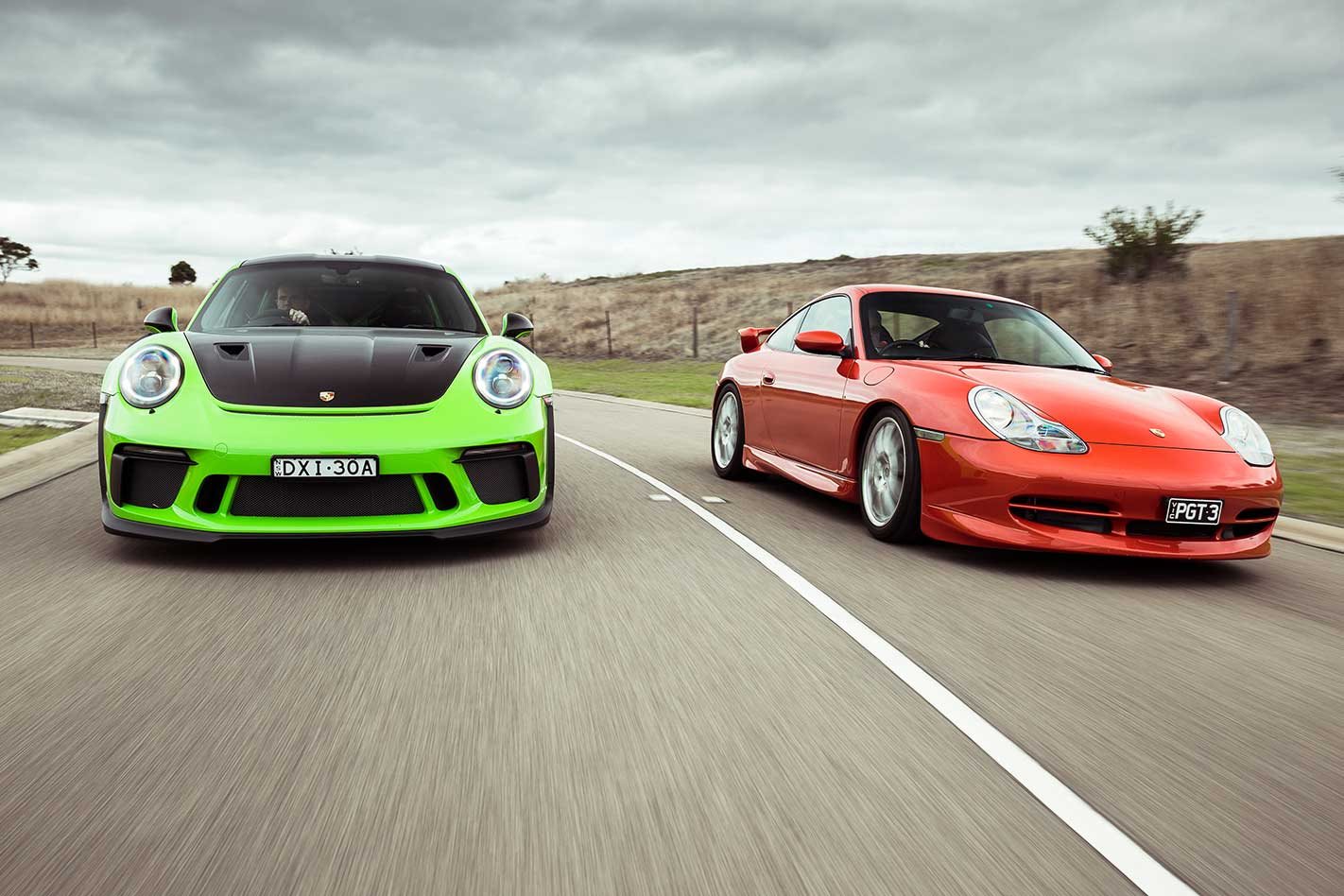“Absolutely brilliant,” said Cameron McConville. “One of the most impressive cars I’ve ever had the pleasure to drive. Damn near impossible to fault.”
Cam had just punted the Porsche 996 911 GT3 to 293km/h at Holden’s Lang Lang proving ground. With a passenger, no less. The occasion was Performance Car of the Year 2000 and Porsche’s new road-racer had just blown everything else away, beating the second-best Maserati 3200GT by 20km/h. Oh, and it was 10 per cent quicker than anything else to 100km/h and over the quarter mile.
Thus started arguably the most impressive run of excellence the performance car world has ever seen. To drive any 911 GT3 is to wonder if driving can get any better, yet history teaches us that every few years a new one will emerge offering greater performance, sharper dynamics and more excitement.
So what better way to celebrate the model’s 20th birthday than to unite the cars that book-end the story – the original 996 GT3 and the latest 991.2 GT3 RS – to examine the evolution that’s transpired over the past two decades?
Undertake incremental progress over a long enough period and the result is substantial change. There is no more obvious example of this than parking a Lizard Green 991.2 GT3 RS next to a Zanzibar Red 996 GT3, kindly supplied by enthusiast Linley Baxter.
They are roughly identifiable as emerging from the same gene pool, but the newer car seems to have slithered through some DNA-modifying radioactive waste in the process. It dwarfs the petite 996, sitting 127mm longer, 115mm wider and 27mm taller, its wheelbase stretched by 103mm and the tracks engorged by 62mm at the rear and a whopping 113mm at the front.
In a sign of changing fashions, the 996 is virtually unadorned, a curvaceous aerofoil, ground-hugging front bumper and air-shaping side skirts the only nods to its circuit focus, the modest 18-inch alloys tucked well inside the arches. In contrast, the 991.2 has had its body continually hacked away in the pursuit of more performance and the guards barely contain the giant staggered rims (20s front; 21s rear).

There’s no better illustration of how far the GT3 has come than in the tyres worn by each car: both are appropriately shod in track-spec Michelin Pilot Sport Cup 2s, but whereas the 996 wears 225/40 and 285/30 front and rear respectively, 265/35s and 325/30s adorn the same axles on the 991.2. But enough spec sheet examination, these cars were built to drive.
The interior of the 996 is a very different place to Porsche’s more recent offerings; the seats are snug, supportive buckets that are very comfortable but covered in the world’s slipperiest leather. Shiny black leather covers almost every surface bar the carbon centre console, the weave having that strange olive green tinge that characterises early uses of the lightweight material.
The steering wheel is large and sits low, almost in your lap, and the engine starts with a key, a moment’s hesitation preceding the familiar rattly idle of a Hans Metzger flat-six. It’s a noise exacerbated by the single-mass flywheel, installed as part of the optional MO30 pack that also added steel gearbox synchros and trackday trinkets like a fire extinguisher and engine cut-out switch.
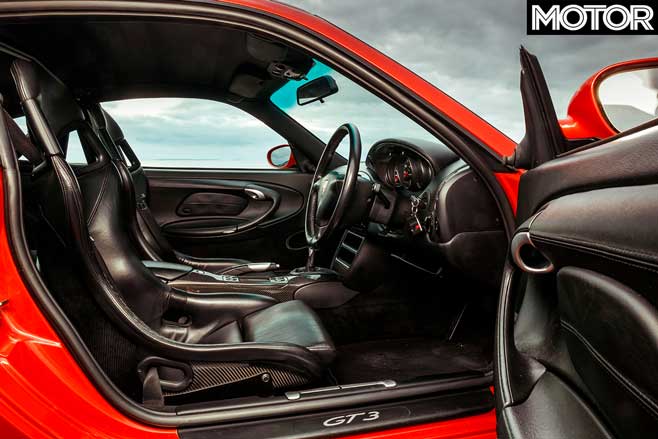
The flywheel endows the engine with incredible response, the revs rising instantly at the slightest brush of the throttle and falling equally quickly, providing plenty of stall potential. It’s mastered easily enough, but when combined with the long throw of the gearbox, shifts have to be completed quickly in order to make smooth progress.
The engine is tremendously flexible and quietly vocal, always present but not intrusive, emitting a strong whoosh under load at low rpm, like a constantly crashing wave. Under brakes the track-biased clubsport pads squeal like a pig with its tail in a vice, but this wasn’t the biggest complaint for road testers back in the day.
It might surprise you to learn that the 996 GT3 didn’t win PCOTY 2000 – not even close. Fourth was the best it could manage, a Boxster S victorious from the BMW E39 M5 and Subaru WRX STi. While full of praise for its ability, the judges felt the GT3 too focused on track use, summarising it thus: The GT3 is noisy, has a ride quality verging on harsh, ducks and weaves to follow every inconsistency. Couldn’t be lived with day-to-day. This proves two things: that former MOTOR staffers were sooks and that what constitutes acceptable ride quality has changed a lot in 20 years.
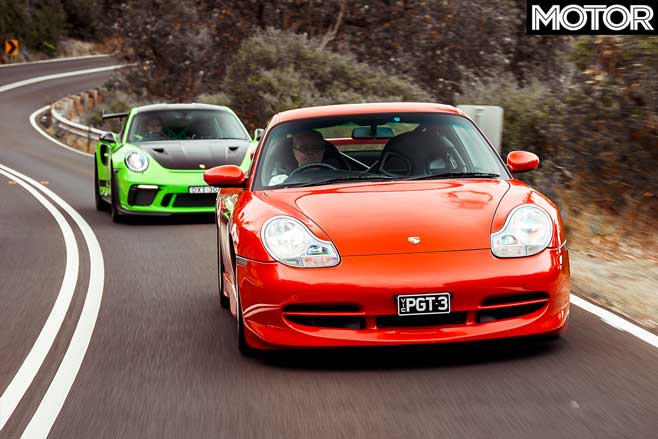
The final quote is interesting, because one of the first thoughts that crossed my mind while driving Linley’s 996 was, ‘I want one of these as a daily driver!’ The ride is firm but compliant, the nose does follow cambers but not to the extent of something like an R35 GT-R, and the only evidence of the GT3’s racing roots is the odd squeak from the half-cage. Today a car this civilised would wear a Carrera badge. If those PCOTY 2000 judges thought the 996 too track-focused, they’d want to lock the latest GT3 RS in a pit garage and throw away the key.
This is not the most hardcore model in Porsche’s recent arsenal; unlike in its GT2 RS big brother, you can’t hear the cogs meshing in the gearbox or the pads gripping the discs under brakes, but the front wheels chase bumps and cambers like a beagle on the scent, there’s a choof from the PDK every time it swaps ratios, the seats lack padding and, even if all the various bits of six-point harness are out of the way, there’s a good chance you’ll knock something sensitive on the crotch strap.
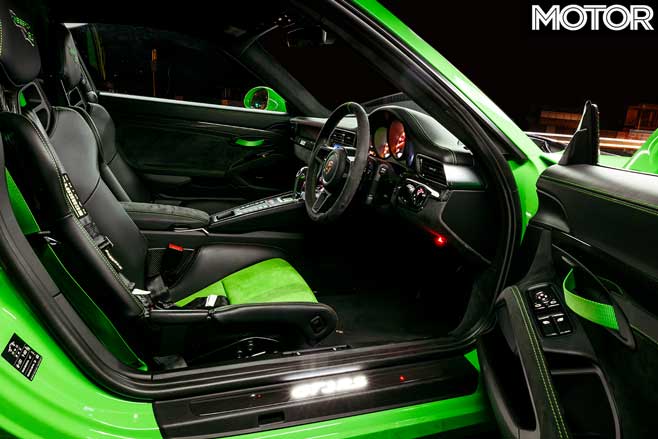
Yet you could enjoy these traits on a daily basis; the flexible engine and self-shifting gearbox make it a cinch to operate in traffic and, despite those monster rims and seemingly zero suspension travel, it has a reasonable ride.
Linley, who also owns a 991.2 GT3 manual, sums it up well when emerging from the RS: “How can they get this car so firm yet it’s still riding the bumps?” Before adding another accurate description of the car as a whole: “That thing’s vicious.”
The 991.2 GT3 RS might just be the most aggressive road car ever created. It’s like a crazed UFC fighter; it carries not an ounce of fat and has to be restrained from tearing the road apart at every opportunity. Spending significant time behind the wheel at pace is exhausting due to the sensory overload; it isn’t a car you can just sit back and relax in, you have to drive it.
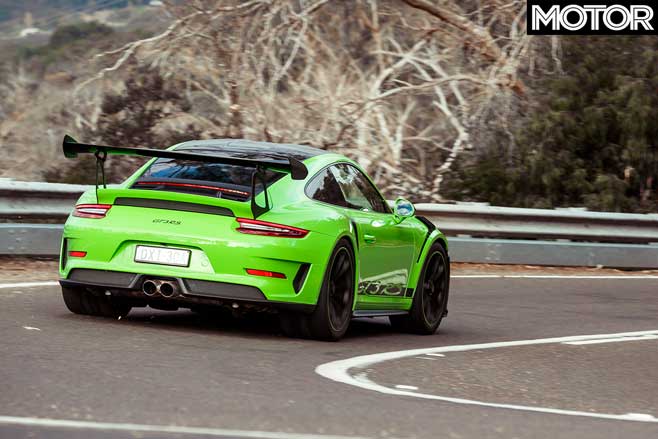
Porsche GT cars boss Andreas Preuninger describes the RS set-up as being close to a Cup car and I can believe it; on a bumpy road at speed it’s like being stuck in a tumble dryer as the suspension refuses to yield to the scarred tarmac.
The upside of this on a smooth road is incredible accuracy. On cold tyres the 991.2 is a bit like a cheetah on roller skates, but as soon as those giant Cup 2s warm up lateral grip is immense. Turn-in, typically a 911 weakness, is incredible thanks to the wider front track, rear-wheel steering and aggressive geometry; traction is strong but the engine has so much urge now that the rear tyres can break free if you’re too keen with the throttle.

Its ultimate limits lie beyond what’s possible on the public road, but the way you feel plugged into the car means you don’t have to drive like you’re in a Top 10 Shootout to enjoy the experience, even if the car wants you to.
What’s remarkable is that the 996 shares many of these traits, particularly in the confidence it gives the driver. Older cars can offer an enjoyable experience but rarely do they egg you on to exploit their limits; spoiled by the subconscious comfort of electronic driver aids, not to mention the latest in suspension, tyre and brake technology, yesterday’s performance cars can leave you feeling a little exposed.
The first-generation GT3 is different. Its only conciliation to driver assistance is ABS, yet it cuddles you in a warm embrace.

The steering is slower but responds to the slightest movement off-centre while offering constant information about what the front end is up to, while the rear sends similar signals through the seat. Linley’s car has around 56,000km on the clock and has been expertly cared for but has also been driven hard on track and yet feels brand new.
Two corners into the twisting Arthur’s Seat hillclimb on Victoria’s Mornington Peninsula, the 996 is whispering in my ear: “Go on, lean on the front tyres and gun it, we’ll generate some oversteer. It’ll be awesome, Linley won’t mind.” On the off-chance he does, I ignore these advances and simply enjoy a car that appears to possess the perfect amount of performance for on-road enjoyment.
In 2019 terms, the original GT3 is not particularly quick. It may have been the dux of the PCOTY 2000 field, but 0-100km/h in 5.00sec and a 13.07sec quarter mile are numbers you’d expect from a $50K AWD hot hatch these days. The engine is beautiful, though: smooth, torquey, keen to rev, perfectly matched to the gearing (unlike a Cayman GT4!) and with that soulful flat-six howl.
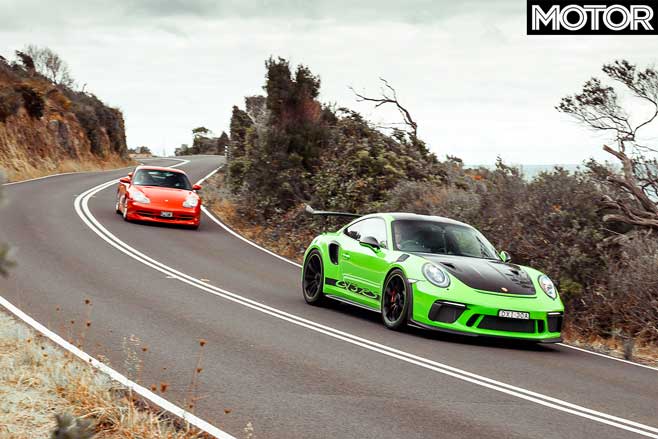
In terms of pace, the 991.2 GT3 RS occupies a different universe: 0-100km/h in 3.18sec; 0-400m in 11.07sec at 203.78km/h. The 4.0-litre flat-six makes a strong case for being the best engine in the world (see page 68); the mid-range is ridiculous for a naturally aspirated engine and the ferocity of the top end is legitimately scary – the ever-increasing acceleration is unnerving and means you have to have your wits about you when approaching corners.
Two decades, six iterations, 118kW and more than a minute of Nurburgring lap time separate this pair, but they are linked by more than just badging and a vague ‘racecar for the road’ message. Drive them back-to-back and it’s clear that even if exactly the same people didn’t develop them both (and there are probably some that did) the same development principles guided both teams.
The 991.2 looks and feels like it’s fuelled by pure testosterone compared to the petite, demure 996, but the way the engine and steering in particular respond is incredibly similar in each. Both are brilliant, near impossible to fault, and two of the most impressive cars I’ve ever driven.
Fast Facts

| u00a0 | Porsche 911 GT3 (996) | Porsche 911 GT3 RS (991.2) |
| Body | 2-door, 2-seat coupe | |
| Drive | rear-wheel | |
| Engine | 3600cc flat-6, DOHC, 24v | 3996cc flat-6, DOHC, 24v |
| Bore x Stroke | 100.0 x 76.4mm | 102.0 x 81.5mm |
| Compression | 11.7:1 | 13.3:1 |
| Power | 265kW @ 7200rpm | 383kW @ 8250rpm |
| Torque | 370Nm @ 5000rpm | 470Nm @ 6000rpm |
| Power/Weight | 196kW/tonne | 269kW/tonne |
| Transmission | 6-speed manual | 7-speed dual-clutch |
| Weight (dry) | 1350kg | 1425kgu00a0 |
| Suspension (f) | struts, coil springs, anti-roll bar | struts, coil springs, adaptive dampers, helper springs, anti-roll bar |
| Suspension (r) | multi-links, coil springs, anti-roll bar | multi-links, coil springs, adaptive dampers, helper springs, anti-roll bar |
| L/W/h | 4430/1765/1270mm | 4557/1880/1297mm |
| Wheelbase | 2350mm | 2453mm |
| Tracks | 1475/1495mm (f/r) | 1588/1557mm (f/r) |
| Steering | hydraulically assisted rack-and-pinion | electrically assisted rack-and-pinion, rear-wheel steer |
| Brakes (f) | 330mm ventilated/drilled discs, 4-piston calipers | 380mm ventilated/drilled discs, 6-piston calipers |
| Brakes (r) | 330mm ventilated/drilled discs, 4-piston calipers | 380mm ventilated/drilled discs, 4-piston calipers |
| Wheels | 18 x 8.0-inch (f); 18 x 10.0-inch (r) | 20 x 9.5-inch (f); 21 x 12.5-inch (r) |
| Tyre Sizes | 225/40 ZR18 (f); 285/30 ZR18 (r) | 265/35 ZR20 (f); 325/30 ZR21 (r |
| Tyres | Michelin Pilot Sport Cup 2 | |
| Price | $224,600 (when new) | $416,100 ($489,350 as tested) |
| Pros | Started a dynasty; remains a sublime drive | Possibly the greatest driving tool thereu2019s ever been |
| Cons | Slippery leather; brake squeal; we donu2019t own one | Too hardcore for some; massive price tag |
| Rating | 5 out of 5 stars | 5 out of 5 stars |


